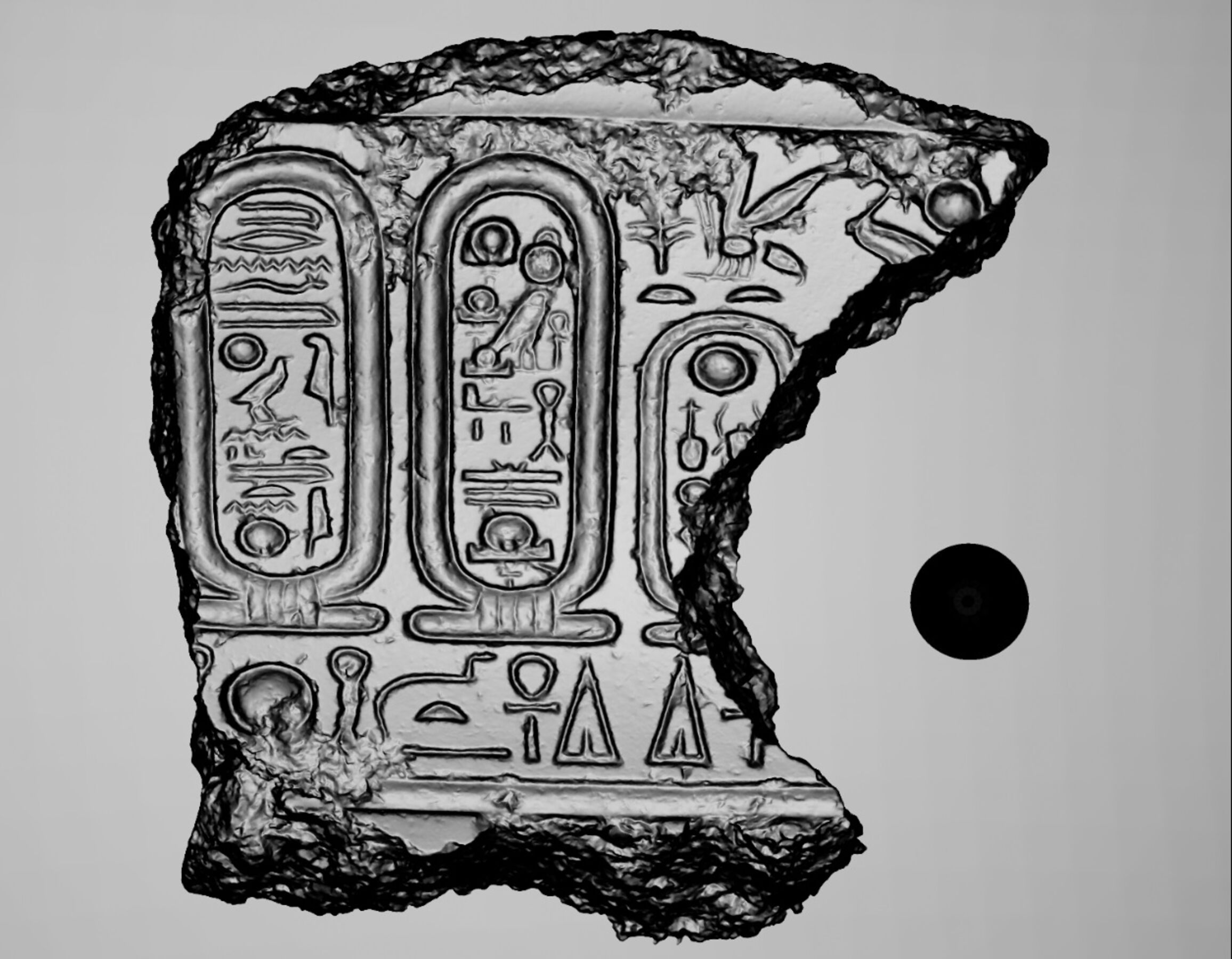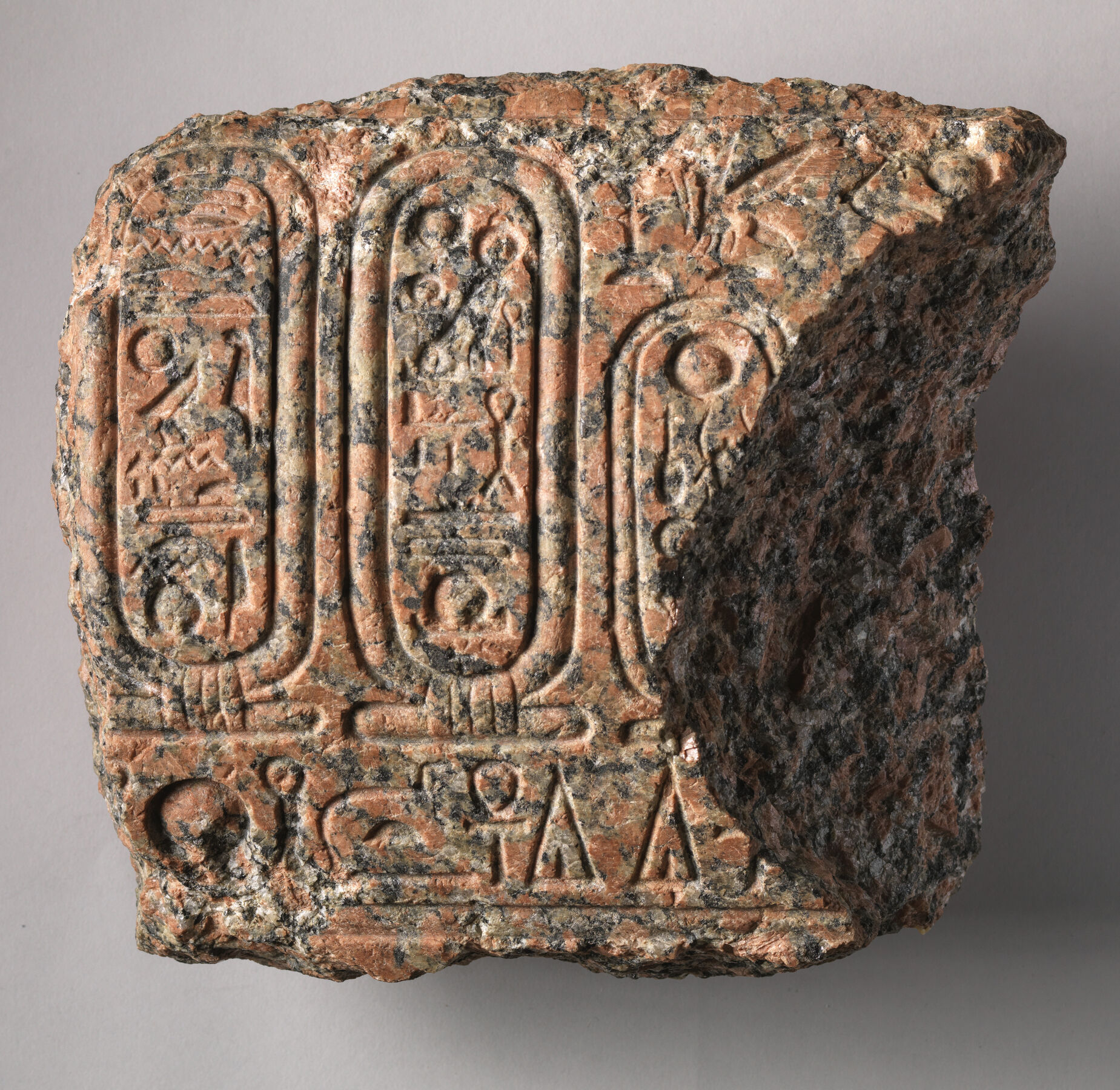King Akhenaten shook the religious foundation of Egypt by eliminating the worship of many gods in favor of one, the Aten sun disk. Akhenaten gave the Aten several didactic names mirroring a royal titulary with its pair of cartouches, placing the god on the same level as the king. Akhenaten was the only intermediary between the people and his sole god in his new religion. In this way, Akhenaten asserted his absolute authority over the religious life and afterlife of the Egyptian people.
Carved in sunk relief, from right to left, are one of Akhenaten’s cartouches and two Aten cartouches.

The partial cartouche gives Akhenaten’s prenomen or coronation name, Neferkheperure-Waenre. The hieroglyphs above read, “the King of Upper and Lower Egypt, Son of Re.” The middle cartouche displays the Aten’s later didactic name, “Re lives, the ruler of the two-horizons who rejoices in the horizon.” The last cartouche gives the Aten’s earlier didactic name, “in his name being the light (Shu) which is the Aten.”1 Inscribed under the two cartouches of the Aten is, “Given life, for ever and ever.” Under the cartouche of Akhenaten is the phrase, “Given life.” When viewed with the aid of RTI (reflectance transformation imaging), the signs under the Aten’s first cartouche are visible and give the god’s earlier didactic name “Re-Horakhty who rejoices in the horizon."2

Marc Gabolde has suggested that the fragment belongs to a sarcophagus lid from Royal Tomb, Amarna number 26, based on its material, inscriptions, and base curvature.3 Among the sarcophagus fragments from Tomb 26 are those that form the cartouche of Neferneferuaten-Nefertiti.4 Since this granite fragment does not belong to any of the excavated lids of Akhenaten, Tiy, or Meketaten buried in the royal tomb, it may belong to the sarcophagus lid of Nefertiti.5 Because of its historical value, the sarcophagus fragment will return to Egypt, where it can be joined with other excavated Nefertiti fragments from the Royal Tomb at Amarna.
MH
-
Wegner, Josef. 2017. The Sunshade Chapel of Meritaten from the House-of-Waenre of Akhenaten. Philadelphia: University of Pennsylvania Press. http://www.jstor.org/stable/j.ctv2t4drp.. ↩︎
-
RTI image is a computational photographic method that captures a subject’s surface shape and color and enables the interactive relighting of the subject from any direction. ↩︎
-
Gabolde, Marc. 2015. Toutankhamon. Les grands pharaons. Paris: Pygmalion.. I would like to thank Marc Gabolde for sharing his research. ↩︎
-
Gabolde, Marc. 1998. D 'Akhenaton à Toutânkhamon. Collection de l’Institut d’Archéologie et d’Histoire de l’Antiquité 3. Lyon: Université Lumière-Lyon 2, Institut d’Archéologie et d’Histoire de l’Antiquité.. ↩︎
-
Gabolde, Marc. 1998. D 'Akhenaton à Toutânkhamon. Collection de l’Institut d’Archéologie et d’Histoire de l’Antiquité 3. Lyon: Université Lumière-Lyon 2, Institut d’Archéologie et d’Histoire de l’Antiquité.. See also Martin, Geoffrey T. 1974. The Rock Tombs of el-'Amarna. Part VII: The Royal Tomb at El-'Amarna I. The Objects. Archaeological Survey of Egypt 35. London: Egypt Exploration Society.. ↩︎
Bibliography
- Gabolde 1998
- Gabolde, Marc. 1998. D 'Akhenaton à Toutânkhamon. Collection de l’Institut d’Archéologie et d’Histoire de l’Antiquité 3. Lyon: Université Lumière-Lyon 2, Institut d’Archéologie et d’Histoire de l’Antiquité.
- Gabolde 2015
- Gabolde, Marc. 2015. Toutankhamon. Les grands pharaons. Paris: Pygmalion.
- Martin 1974
- Martin, Geoffrey T. 1974. The Rock Tombs of el-'Amarna. Part VII: The Royal Tomb at El-'Amarna I. The Objects. Archaeological Survey of Egypt 35. London: Egypt Exploration Society.
- Wegner 2017
- Wegner, Josef. 2017. The Sunshade Chapel of Meritaten from the House-of-Waenre of Akhenaten. Philadelphia: University of Pennsylvania Press. http://www.jstor.org/stable/j.ctv2t4drp.
